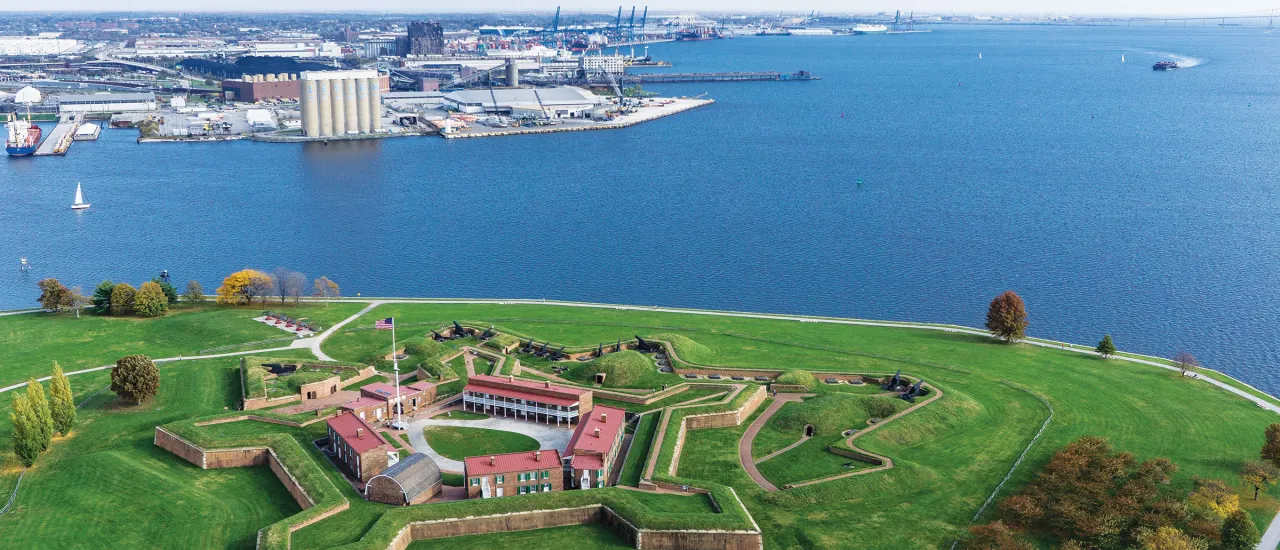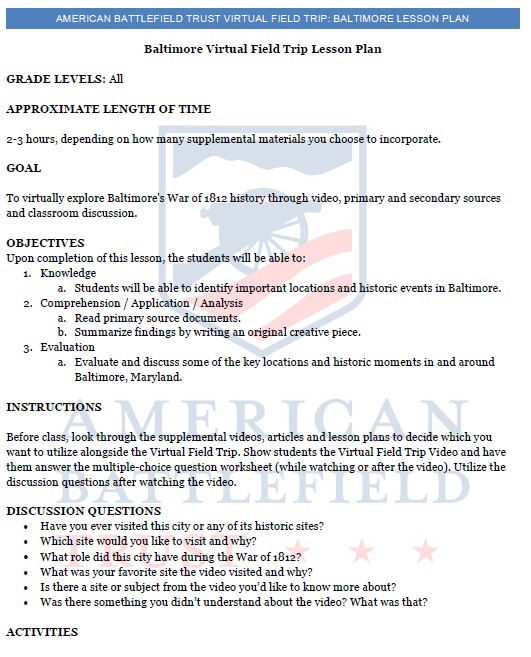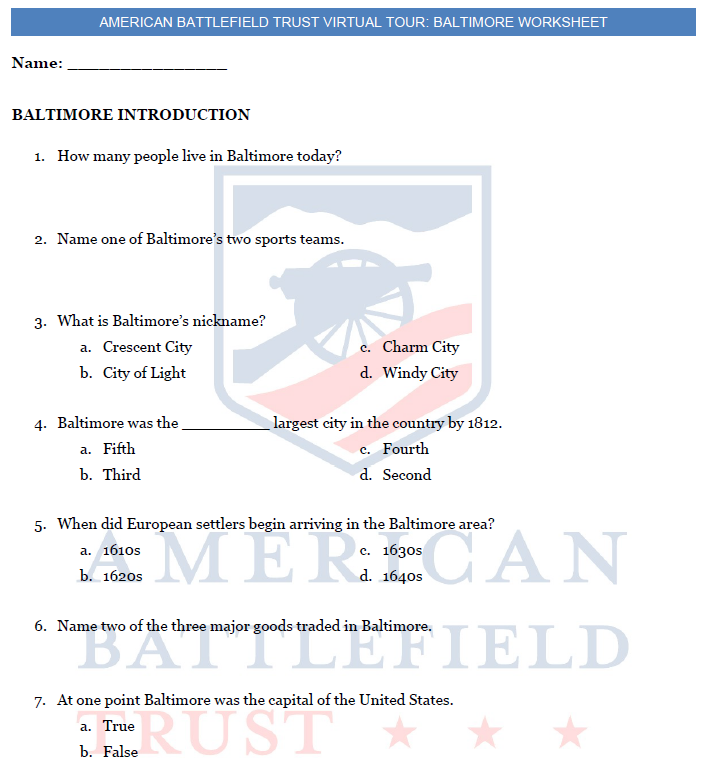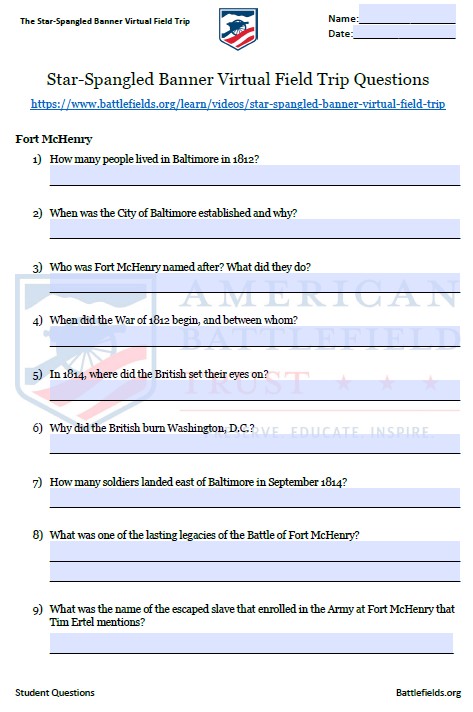
Star-Spangled Banner Virtual Field Trip Lesson Plan
A lesson plan for use in middle and high school classrooms.
If you're watching the Star-Spangled Banner Virtual Field Trip video with your students, it might be the perfect opportunity to explore even more of Baltimore's history and culture! This lesson plan includes a range of resources about the bombardment of Fort McHenry, the inspiration for the National Anthem, and slavery in the Antebellum period.
This Lesson Plan can be used as a prepared resource by following this curriculum plan which aligns to NCSS and Common Core Standards.
This Lesson Plan's assets can also be used on their own as supplemental resources. The display format is prepared for easy access, exploring, and learning.
To virtually explore Baltimore's War of 1812 history via video, primary and secondary sources and classroom discussion.
Upon completion of this lesson, the students will be able to:
1. Knowledge
- Students will be able to identify important locations and historic events in Baltimore.
2. Comprehension/Application/Analysis
- Read through primary source documents.
- Summarize findings by writing an original creative piece.
3. Evaluation
- Evaluate and discuss some of the key locations and historic moments in and around Baltimore, Maryland.
Check out the Lesson Plan Teaching Guide for more instructions on using the prepared Lesson Plan.
Lesson Plan Primary and Secondary Source Activity:
- Watch some or all the Star-Spangled Banner Virtual Field Trip video.
- Conduct a group discussion utilizing the discussion questions:
- Have you ever visited this town or any of its historic sites?
- Which site would you like to visit and why?
- What role do you think the city played in the War of 1812?
- What was your favorite site the video visited and why?
- Is there a site or subject from the video you’d like to know more about?
- Was there something you didn’t understand about the video? What was that?
- Have the students complete the Video Question Quiz Worksheet.
- If the entire Virtual Field Trip video was watched, have the students complete all of it.
- If only some of the Virtual Field Trip video was viewed, have the students complete the relevant sections.
- Have the students complete one of the following exercises utilizing primary and secondary sources to influence a creative piece.
- Have the students read a couple of the following:
- Have the students write a diary entry from the perspective of someone stationed at Fort McHenry based on what they saw in the Virtual Field Trip video and read above. They could be a regular soldier, a musician or an officer.
- Complete an optional exercise.
OPTIONAL HOMEWORK/ASSESSMENT/ADDITIONAL ACTIVITIES:
Option 1:
Break students into small groups and assign one or two chapters of the video for each group to watch. Have the groups only watch their assigned sections. After viewing, have the small groups present what they learned to the class.
Option 2:
Have students research one aspect of the video that piqued their interest. They can prepare a 500-word paper or present their findings to the class in the form of an in-person or video presentation.
Option 3:
Individually, in groups, or as a classroom read The Star-Spangled Banner, and have the students make a list of words they don’t know or they question the use of the word in the poem. As a group, discuss the words and find 19th century definitions. Discuss if certain words have taken on new meanings or if they were perhaps a unique choice even in 1814. One of the popular songs from the War of 1812, are there national and patriotic themes that would have resonated with Americans after their war victory?
Option 4:
In the Virtual Field Trip, the speakers discuss Fort McHenry being a star-shaped (pentagonal) fort. Have students research a fortification from the Revolutionary War, the War of 1812, or the Civil War and identify the chosen fort’s strengths and weaknesses. Have them explore how the fort’s shape and building material impacts the soldiers (attacking or defending):
- French and Indian War
- Revolutionary War
- War of 1812
- Civil War
Have the students present their findings.
Option 5:
Have students read about the enslaved people at Hampton National Historic Site. Individually, in groups, or as a classroom, have students identify the roles and vital work that enslaved people did at Hampton. What are some ways to meaningfully remember or memorialize their building, creating or work?
- Chattel Slavery at Hampton - Hampton National Historic Site (U.S. National Park Service)
- Working Conditions - Hampton National Historic Site (U.S. National Park Service)
- Forms of Control - Hampton National Historic Site (U.S. National Park Service)
- Harriet Hawkins - Head Dressmaker (U.S. National Park Service)
- Toby - Iron Founder (U.S. National Park Service)
- Hampton's Cooks - Hampton National Historic Site (U.S. National Park Service)
- Nancy Davis - Child Care (U.S. National Park Service)
Option 6:
Have students read about Mary Pickersgill, the making of the Star-Spangled Banner and how it got its fame. Additionally, they can read one of the following primary sources: "The Noted Flag Which Waved Over Fort McHenry" or War of 1812: "The Star-Spangled Banner". Then, have students write a short news report about the flag following the bombardment of Fort McHenry.
Common Core State Standards- ELA & History/Social Studies
Grades 6-8
- Key Ideas and Details:
- CCSS.ELA-LITERACY.RH.6-8.2
- Determine the central ideas or information of a primary or secondary source; provide an accurate summary of the source distinct from prior knowledge or opinions.
- CCSS.ELA-LITERACY.RH.6-8.2
- Craft and Structure:
- CCSS.ELA-LITERACY.RH.6-8.6
- Identify aspects of a text that reveal an author's point of view or purpose (e.g., loaded language, inclusion or avoidance of particular facts).
- CCSS.ELA-LITERACY.RH.6-8.6
- Integration of Knowledge and Ideas:
- CCSS.ELA-LITERACY.RH.6-8.9
- Analyze the relationship between a primary and secondary source on the same topic.
- CCSS.ELA-LITERACY.RH.6-8.9
Grades 9-10
- Key Ideas and Details:
- CCSS.ELA-LITERACY.RH.9-10.2
- Determine the central ideas or information of a primary or secondary source; provide an accurate summary of how key events or ideas develop over the course of the text.
- CCSS.ELA-LITERACY.RH.9-10.2
- Craft and Structure:
- CCSS.ELA-LITERACY.RH.9-10.6
- Compare the point of view of two or more authors for how they treat the same or similar topics, including which details they include and emphasize in their respective accounts.
- CCSS.ELA-LITERACY.RH.9-10.6
- Integration of Knowledge and Ideas:
- CCSS.ELA-LITERACY.RH.9-10.9
- Compare and contrast treatments of the same topic in several primary and secondary sources.
- CCSS.ELA-LITERACY.RH.9-10.9
Grades 11-12
- Key Ideas and Details:
- CCSS.ELA-LITERACY.RH.11-12.2
- Determine the central ideas or information of a primary or secondary source; provide an accurate summary that makes clear the relationships among the key details and ideas.
- CCSS.ELA-LITERACY.RH.11-12.2
- Craft and Structure:
- CCSS.ELA-LITERACY.RH.11-12.6
- Evaluate the authors' differing points of view on the same historical event or issue by assessing the authors' claims, reasoning, and evidence.
- CCSS.ELA-LITERACY.RH.11-12.6
- Integration of Knowledge and Ideas:
- CCSS.ELA-LITERACY.RH.11-12.9
- Integrate information from diverse sources, both primary and secondary, into a coherent understanding of an idea or event, noting discrepancies among sources.
- CCSS.ELA-LITERACY.RH.11-12.9
Social Studies - National Council for the Social Studies
- Theme 2: Time, Continuity, and Change
- Theme 3: People, Places, and Environments
- Theme 6: Power, Authority, And Governance
This Lesson plan
contains the following:
7 Activities | 39 Resources
Audience: Middle school | High school


